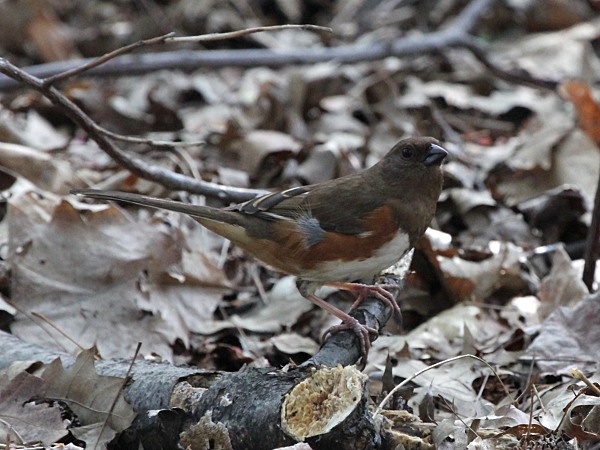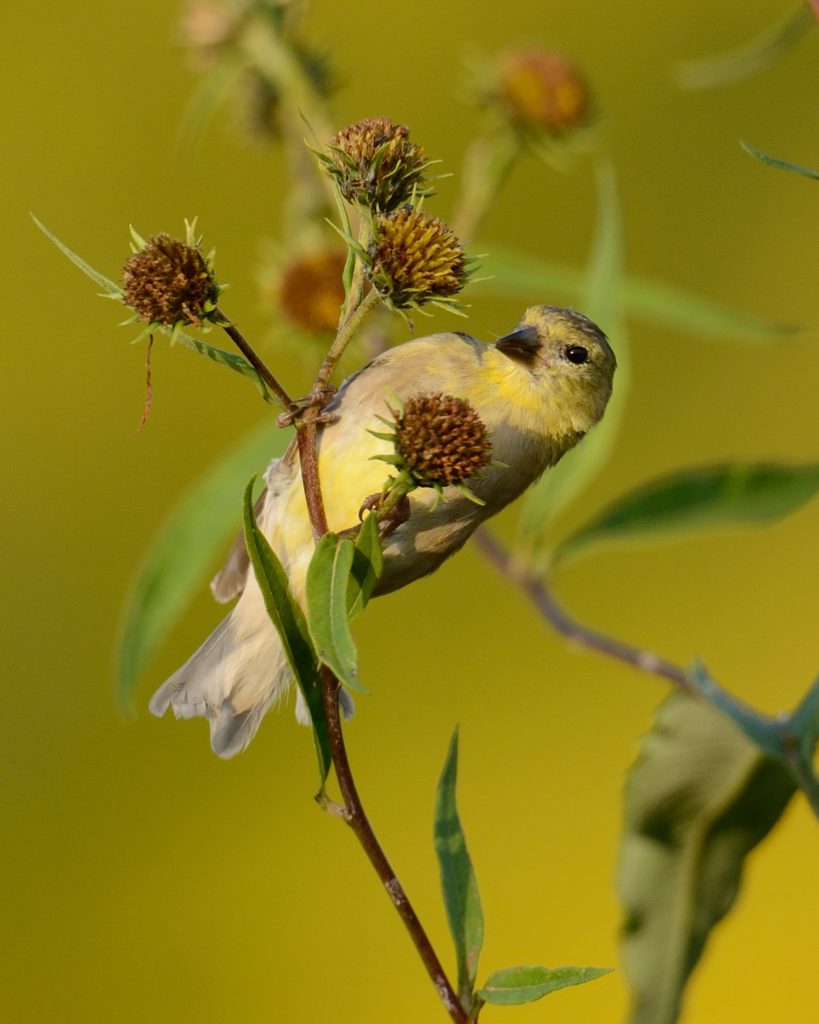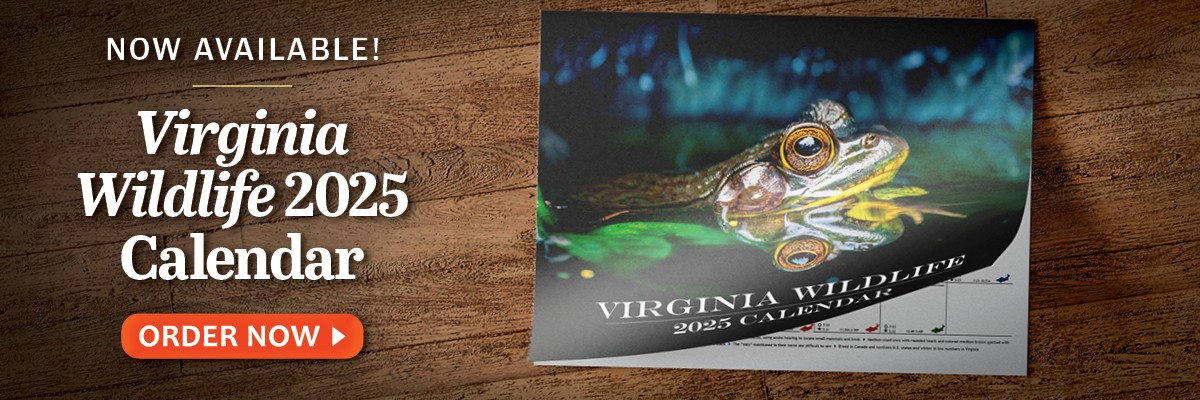
American goldfinch feeding on seedheads. Photo By Jeff Bryant.
By Jessica Ruthenberg, Watchable Wildlife Biologist, Virginia Department of Wildlife Resources
As the weather cools and the leaves change color and begin to fall, it may conjure images of hours spent at home cleaning up gardens, raking leaves, or mowing brush. Whether you are a homeowner or a private landowner, these ritual seasonal chores, are not only time consuming, but they can also negatively impact birds by removing important food and shelter they need to thrive in cooler months. By leaving habitat in place, birds will be more attracted to your property. As the Department of Wildlife Resources’ (DWR) Small Game Project Leader, Marc Puckett explains, “Autumn is a time when birds need cover and seeds, pollinators need the last fall nectar, and insects still need plants as hosts.” All those seeds and insects provide valuable food for birds.
Consider changing up your fall routine in order to attract and support birds this fall through winter. Here are some easy tips from DWR’s habitat experts. And good news—less is more!
Easy Yard and Land Maintenance Tips to Help Birds Thrive from Fall through Winter

Thickets, weeds and brush, such as the winged and staghorn sumacs and other native shrubs in this old field, provide excellent fall and winter shelter for songbirds. Photo by Marc Puckett
For private landowners, Puckett, recommends,
“First and foremost – do not mow old fields during fall. Mowing during fall will result in an area devoid of cover all winter long—wait until early to mid-March to mow, if possible. And perhaps even more importantly, even if you do mow in fall, don’t mow it all every year. Mow in rotation, either half or one third, annually on a two- or three-year cycle. This way no matter when you mow, you will still be leaving cover on part of the land year round.”
So, by not mowing or by mowing less land, you can actually do more for birds. Similarly, homeowners need not worry about raking and bagging leaves. DWR’s former Habitat Education Coordinator, Carol Heiser, says, “One of the most important things you can do for wildlife is to allow the leaves to stay on the ground, rather than bagging them up and throwing them away. The dead leaves act as a kind of cover or blanket for dormant insects, and leaf cover can also keep the soil from eroding.” So leave your leaves or rake them up into your garden beds and use them as mulch, rather than bagging and throwing them away.
Homeowners should also consider taking it easy on the fall garden cleanup, ideally leaving the cleanup for spring. Heiser recommends, “Keep your garden beds intact. When you leave the dry stalks and seedheads standing, they provide a safe place for insects to lay their eggs for next year’s cycle, and for birds to hide from predators.” All those seedheads are also full of seeds that birds can pick on through fall and winter; they are nature’s bird feeder.

Eastern towhee foraging through fallen leaves. Photo By Vitalii Khustochka
For anyone still wanting some fall chores to do, one helpful action that any homeowner or landowner can take is to plant native shrubs and trees. Heiser says, “Fall is the best time to plant native shrubs and trees because their roots will be going dormant soon anyway, so there’s less trouble with transplant shock.”
For landowners, Puckett suggests, working on eliminating undesirable lawn, such as fescue grass, which provides no value for birds or other wildlife and prevents growth of the native grasses and wildflowers that they do need.
“Fall is a great time to spray sod-forming fescue grass, if it is invading your land and if not in an area prone to soil erosion. Fescue can be sprayed with herbicides effectively into early December, if there have not been too many hard frosts and the grass is still green. By spraying at this time, you can kill the fescue without harming other beneficial plants that are dormant.”
However, Puckett is quick to caution about spraying in a wildflower meadow. “Many wildflowers stay susceptible to herbicides even when the flowering portion of the plant is dead. So, for a wildflower meadow being invaded by fescue grass, it would be better to use a grass selective herbicide,” he said. He adds, “Remember to follow the label directions–the label is the law.”
To continue your habitat actions for birds into the winter, Puckett recommends, “The cold weather is a great time to kill and remove non-native invasive trees and shrubs, like Tree-of-Heaven (Ailanthus altissima), privet, autumn olive and others. During this time of year, treatments with proper herbicides are highly effective at controlling undesirable trees and shrubs. By eliminating non-native invasive plants, native species that are preferred by birds and other animals are given a chance to flourish.”
Simplifying your routine fall yard and land maintenance practices really can make a difference for birds; follow these tips from DWR’s habitat experts and your property will be more attractive and supportive to birds. They will be well fed and sheltered and you will enjoy improved birdwatching this fall and winter and for years to come.

American goldfinch feeding on seedheads. Photo By Janet and Phil
Additional Habitat Resources
- For private landowners, DWR has a team of five private lands wildlife biologists (PLWBs), hired jointly with Virginia’s Natural Resources Conservation Service (NRCS), that specialize in on-site landowner habitat evaluations followed by detailed management planning where appropriate. Interested landowners can find out if their area is suitable by contacting their local PLWB or Marc Puckett at 434-392-8328, marc.puckett@dwr.virginia.gov.
- The DWR’s habitat webpage – Find numerous resources for improving habitat
- Habitat at Home© booklet – Find habitat landscaping tips and the best native tree and shrub choices to support birds and other wildlife.
- Information on herbicide application methods for removing non-native invasive trees and shrubs, can be found at https://content.ces.ncsu.edu/accomplishing-forest-stewardship-with-hand-applied-herbicides.
- Managing Land in the Piedmont of Virginia for the Benefit of Birds & Other Wildlife – Find land management recommendations that benefit birds in this introductory how-to guide.
- Virginia Native Plant Society – For a list of nurseries that sell Virginia native plants



